Toto, I’ve a feeling we’re not in Kansas anymore.
–Dorothy
The three of you who pay close attention to my ramblings may recall that a couple of months ago, I wrote about the origin of the name sycamore, applied to both a kind of maple in Europe, and a kind of planetree in North America. The name supposedly refers to the shape of the leaves, and traces back to the sycomore fig (Ficus sycomorus). However, as far as I could determine, the sycomore fig’s leaves look nothing like those of either kind of sycamore. So what gives? I was determined to find out, so I booked a flight to South Africa [Truth-O-Meter: True] so that I could settle the question once and for all [Truth-O-Meter: Pants on Fire].
As it happened, I found a sycomore tree fairly quickly. This is the only one I saw that had fruit:
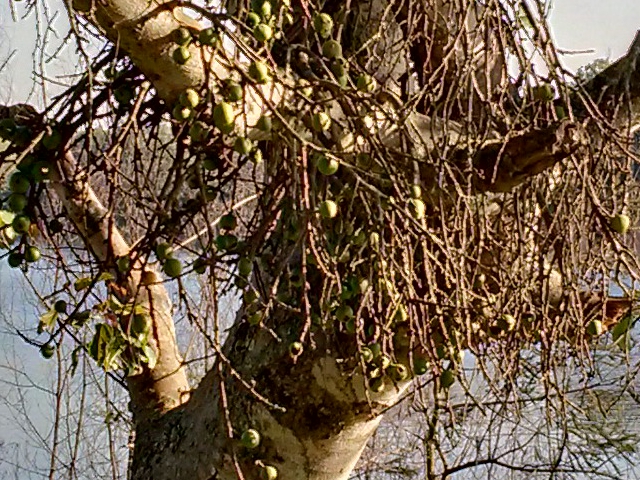
[Apologies for the poor image quality, but I only had my cell phone at the time, and the lighting was terrible.]
And, as various online sources suggest, the leaves look nothing like those of a sycamore (of either kind):
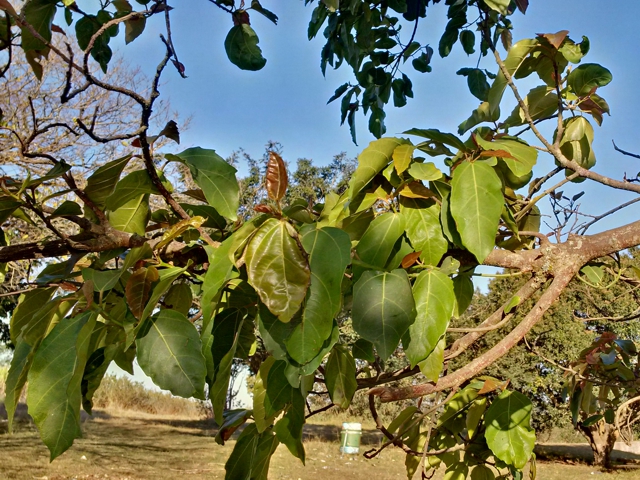
So, I have to go with my earlier hypothesis that somebody got a different kind of fig confused with the sycomore (possibly F. carica), and it’s really that other kind after which the sycamore (either kind) was named.
Having more or less resolved that issue, I decided to spend the next couple of weeks walking through the woods of South Africa [Truth-O-Meter: Mostly False]. In doing so, I faced some challenges: I know very little about the trees of South Africa, so I usually had no idea what I was looking at. And, it being winter, almost nothing was flowering. Add to that the fact that in most of South Africa, winter is also the dry season, which meant that many of the trees had lost their leaves. And did I mention that South Africa is mostly grassland? There just aren’t many trees to begin with.
Nevertheless, I soldiered on (all for you, dear reader). Fortunately, I did a lot of my woods-walking in national and regional parks, and many of the trees in these parks share a key characteristic that simplifies identification:

These signs were pretty neat, and something I hadn’t seen before: If you scan the QR code with your smartphone, it takes you to a web page with more information about the plant. (And yes, as you can guess from the scientific name, plants in this genus are the original source of the neurotoxin strychnine.)
But, like any product of modern technology, this one, too, has bugs:

The QR code on this sign does take you to a web page, but it’s the wrong one, for a different tree. Here’s what the tree itself (the right one, not the wrong) looks like:
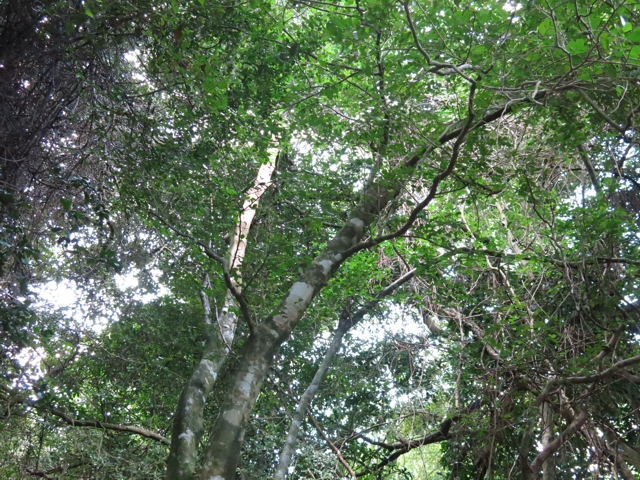
Jackal-berries are in the genus Diospyros, which is the genus of both ebony and persimmon. Most Disopyros species are fairly small and therefore not commercially valuable, but nearly all of them have very hard wood, with the heartwood usually dark brown or black. The wood of these smaller trees is used for ornamental turnings and the like. The fruit looks a lot like a small persimmon:

(This one is a common jackal-berry, D. mespiliformis.)
Let’s officially begin our walk near the west coast, in the Northern Cape in an area known as Namaqualand (or, sometimes, the “succulent Karoo,” which is a pretty evocative name, if you ask me). Namaqualand is arid, not quite desert but close. There is very little rainfall, but some moisture does arrive from the Atlantic Ocean. There are virtually no trees, but like the deserts of the southwestern U.S. that are dominated by tree-like cacti, Namaqualand is also dominated by large succulents, only these are aloes, rather than cacti:
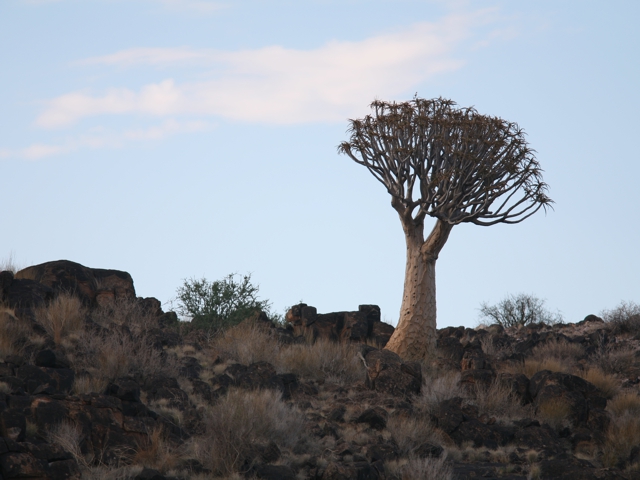
This one is the quiver tree, Aloe dichotoma. Although it appears substantial, the “trunk” is hollow and fibrous, resembling more a giant loofah than a log. The barren Namaqua landscape is punctuated by the desiccated skeletons of long-dead quiver trees:
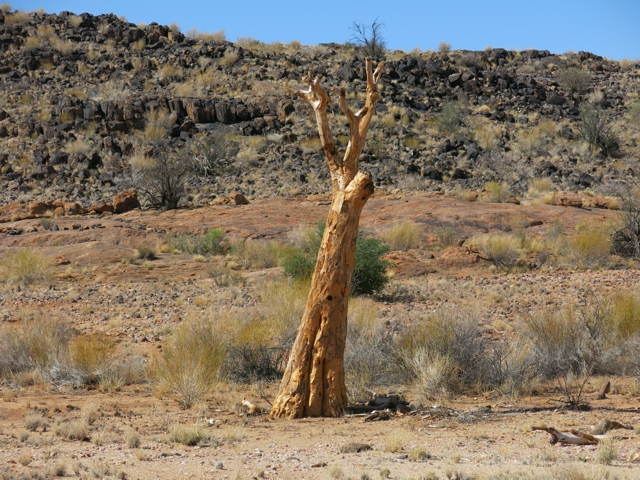
As we travel eastward and inland, we move away from the ocean influence, and enter the Great Karoo:
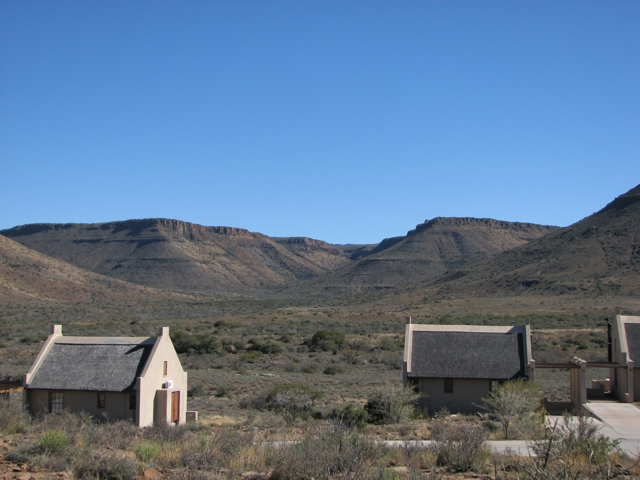
There are still no trees (except along water courses), and the terrain and vegetation are strongly reminiscent of the Great Basin in North America. The few large trees that do exist are heavily (and I do mean heavily) utilized by Sociable Weavers (Philetairus socius):

The tree is an acacia of some kind, possibly sweet thorn (Vachellia karroo), but I’m not sure.
Even further east, we enter the Kalahari grasslands:
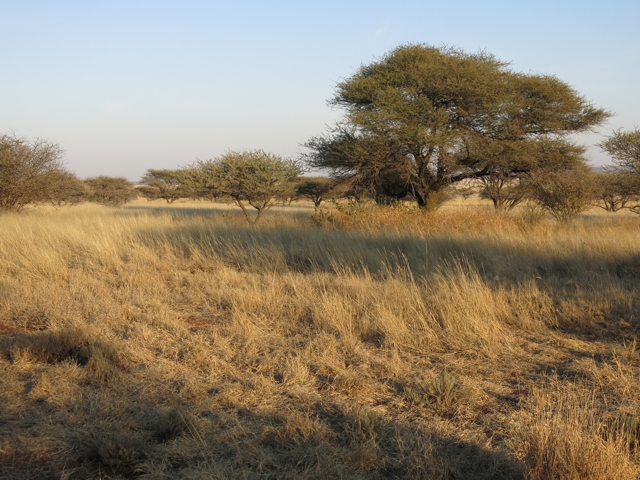
The Kalahari Desert itself is found mostly in Namibia and Botswana, extending just barely into South Africa, but the surrounding Kalahari Basin extends as far south as the city of Kimberley. This is still predominantly grassland, but you do begin to see small trees here and there. After spring rains, the area greens up quite a bit (this photo is from 2012, in December):
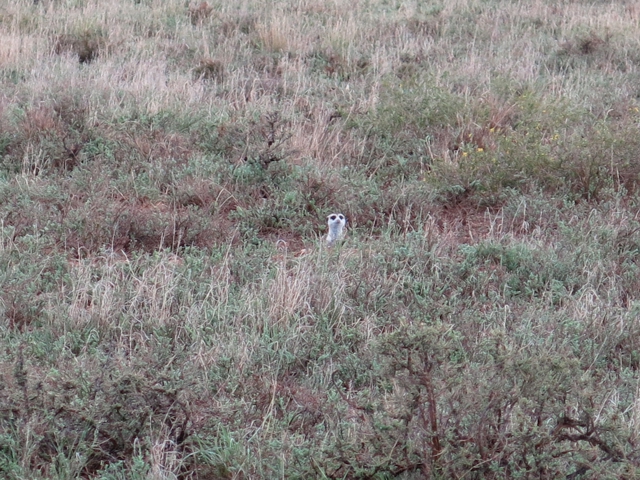
That meerkat (Suricata suricatta) was giving me a “Who are you and what are you doing in my front yard?” look.
Like other plants of arid regions around the world, nearly all of the shrubs and trees in the Kalahari are covered with thorns or spines:

This one is a common spike-thorn (Gymnosporia heterophylla). Its closest North American relatives are American bittersweet (Celastrus scandens) and eastern burningbush or wahoo (Euonymus atropurpureus), both vines.
Around the edges of the basin, you start to see “real” trees. This camelthorn acacia (Vachellia erioloba) was at Sandveld Nature Reserve, in Free State:
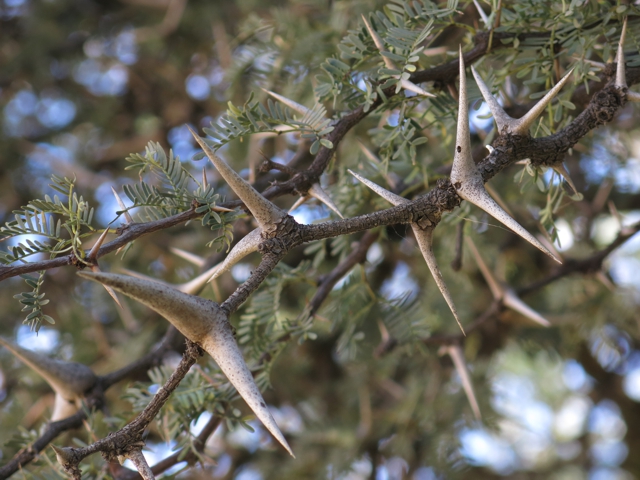
Like most other legumes, the wood is very hard and difficult to work. The “camel” in the name refers to giraffes, which use their long prehensile tongues to delicately pluck off the leaves from between the thorns of this and other acacias. In response to the browsing, the trees quickly begin to produce bitter tannin in the foliage, inducing the giraffe to move on to another plant. (Other trees, such as some oaks, respond similarly, but the acacia’s response is remarkably fast, on the order of five to ten minutes.)
As a rule, the many species of acacia have very similar foliage, so it’s difficult to tell one from another by looking at the leaves. But the flowers and especially the fruit are often very distinctive. The seed pods of the camelthorn are large and robust:
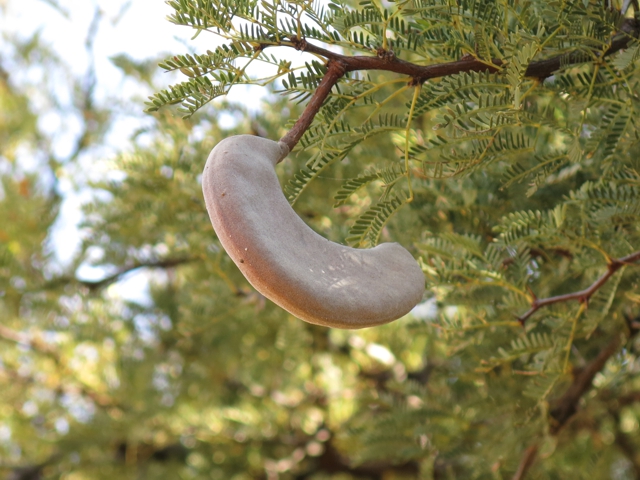
Moving south to the southern Indian Ocean coast, we find true forest, here at Tsitsikamma National Park, in Eastern Cape:

The dominant trees (by size, at least) in these coastal montane forests are Outeniqua yellowwood (Afrocarpus falcatus), and “true” yellowwood (Podocarpus latifolius). Both are botanically softwoods, in the family Podocarpaceae, distantly related to pines. The wood of true yellowwood is reasonably hard and has good workability, and so is prized for furniture and architectural millwork. Outeniqua yellowwood is softer and more likely to be found in utilitarian applications. The true yellowwood is also the national tree of South Africa.
These yellowwood logs (I don’t know which species) were in the process of being harvested after having been downed during a strong winter storm in 2008:
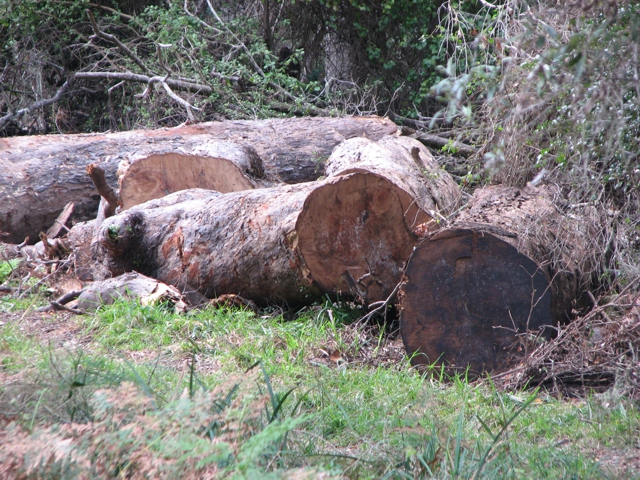
It’s hard to tell from the photo, but the logs are quite large, close to three feet in diameter.
As we continue up the coast to the east, the terrain becomes less mountainous. In isolated valleys, we find scarp forest, such as here at the Dlinza Forest Reserve in Eshowe:

This view is from an observation tower overlooking the forest. From the tower, we were able to get a treetop look at the fruit of a fig (F. thonningii) that is common in this forest:

If you look closely at the forest photo above, you can see what looks like a pom-pom on a stick on the horizon. This is a Natal cabbage-tree (Cussonia sphaerocephala). The scientific name means “spherical head.” Here’s another cabbage-tree, this one with multiple heads (the hydra of the cabbage-tree realm, it would seem):
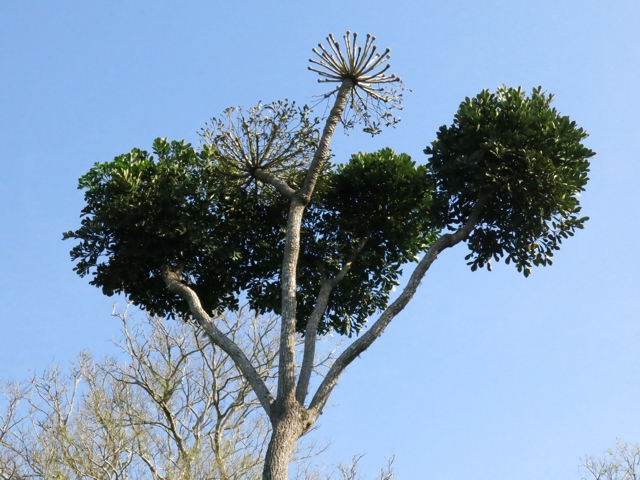
The interior of the scarp forest looks not all that different from a temperate forest in North America, although the trees here grow more slowly and therefore tend to be more twisted and bent:

As is generally the case in areas colonized by Europeans, many of the plants and animals are named after familiar species that they resemble, even if in reality they are not closely related. Thus, we have this wild-poplar or false-poplar (Macaranga capensis):

With enough squinting, you can imagine that the leaves on this tree somewhat resemble those of an aspen or poplar. But the tree is actually in the spurge family Euphorbiaceae. Most spurges are shrubs or forbs, with a few species occurring in the southwestern U.S. The one species that most people are familiar with is the poinsettia (Euphorbia pulcherrima), native to Mexico. The wood of the false-poplar is said to be used for furniture, but I would personally be hesitant to work with it, as most spurges contain compounds that range from mildly irritating to, in the case of the castor bean, deadly poisonous.
The largest trees at Dlinza are the wild-plums (Harpephyllum caffrum):

For scale, the vine that hangs down in front of the tree is about twelve feet off the ground. As with the false-poplar, wild-plums are unrelated to what we call plums, and are in the sumac family Anacardiaceae, relatives of cashews, mangoes, and pistachios. Likewise, most members of this family contain toxic compounds. With sumacs, the toxin is urushiol, the active ingredient in poison oak/poison ivy. The wood is used for general-purpose construction, but is otherwise not notable.
The eastern corner of South Africa is home to lowland coastal forest:

One of the more common trees here is waterberry (Syzigium cordatum), a kind of myrtle:

I couldn’t find any information on the use of the wood, but the trees are fairly small and gnarly, so I suspect it has no widespread use. The berries (not present in winter) are apparently tasty.
The lowland forest in St. Lucia is also where we had an unexpectedly close encounter with a hippopotamus one evening. That’s a story for another time, but suffice to say that it was a Very Good Thing that we were standing in the adjacent parking lot, rather than walking in the woods, at the time.
Nearby, at Cape Vidal in iSimangaliso (“miracle and wonder”) Wetland Park, I found the only blooming woodland wildflower of the trip:

I have not the slightest idea what it is. It seems to have characteristics of both orchids and irises, which means that it might be a member of the order Asparagales. There are only about 36,000 species in that order….
Heading back northwards, we cross onto the Great Escarpment and the southern end of the Drakensberg (“mountain of dragons”). This is the beginning of the highveld (“high field”). The habitat is once again mostly grassland, but with pockets of woodland along the riparian corridors, such as here in Golden Gate Highlands National Park (in summer):

Near Johannesburg, the climate is drier, and the forest more sparse:

(Those odd-looking dark cylinders are another kind of aloe, A. marlothii.) Here, at Suikerbosrand (“sugarbush ridge”) Reserve, the trees once again become small and gnarly. The karee (Searsia lancea), another member of the sumac family, has hard wood that resembles yew and is likewise used for archery bows:

The buffalo thorn (Ziziphus mucronata) is in the buckthorn family Rhamnaceae:

The closest North American relative that I know of is Carolina buckthorn (Rhamnus caroliniana). My main reason for including this tree, however, is the Afrikaans name:

How can you not love a tree called “Blinkblaar-wag-’n-bietjie”? The name translates to “shiny-leafed wait-a-minute.” Other shrubs with recurved thorns, such as the catclaw acacia of Arizona (Senegalia greggii) also go by the name “wait-a-minute” or “wait-a-bit,” which comes from what people invariably say after getting tangled up by accidentally walking into one.
Finishing up in the northeastern corner of South Africa, we drop back off the Great Escarpment and enter the lowveld in Kruger National Park, extending from the province of Limpopo at the north end to Mpumalanga in the south. This is the southern limit of what we think of when we visualize the vast savannahs of eastern Africa. It is a mixed woodland/grassland habitat, with shrubs and small to medium-sized trees scattered throughout. In the far north we can find huge baobabs (Adansonia digitata), which are fairly uncommon in South Africa (they are much more common in Zimbabwe, Mozambique, and Tanzania, to the north and east):

This region is also the home of the only wood from the area that is commercially exported: African blackwood (Dalbergia melanoxylon). In South Africa, the climate is a little too dry, and blackwood (known locally by the Swahili name mpingo) grows as small, multi-trunked trees that are little more than large shrubs (much like eastern redbuds in the U.S.). You have to go further east into Mozambique and Tanzania before you find trees that are large enough for harvest. Much of the wood goes to the manufacture of clarinets, oboes, and other woodwind instruments.
A view from the Mlondozi picnic area near the Lower Sabie camp in Kruger gives an overall impression of the lowveld:

(For what it’s worth, according to Google Translate, the Zulu word “mlondozi” means “skin.”) The larger trees of the lowveld are nearly always located near water.
One common lowveld tree that anyone can remember is fever tree (Vachellia xanthophloea):

Its Grinch-colored bark is instantly recognizable. The fever tree was named by early European settlers, who noticed that the likelihood of contracting malaria was greater in the vicinity of the trees (which tend to grow in swampy areas harboring mosquitoes).
Traveling around Kruger, the most common large tree that I saw was Natal mahogany (Trichilia emetica):

Like African mahogany (Khaya), as well as sapele and sipo (Entandrophragma), Trichilia really is related to mahogany. The wood looks similar to those other species. While researching this species online I discovered that it is sometimes grown in a container as a houseplant.
Another common tree (also in the mahogany family Meliaceae) is cape-ash (Ekebergia capensis). The leaves do look a bit like those of ash:

The bark is different, though:

The bushwillows (Combretum sp.) are readily recognized by their four-winged samaras. This one is russet bushwillow (C. hereroense):

The only tree I found in full bloom was knob-thorn (Senegalia nigrescens):

The profusion of cream-colored flowers made these large trees easy to recognize from a distance. Other related legumes, identified once again by their seed pods, are the sicklebush (Dichrostachys cinerea):

and bullhorn acacia (Vachellia cornigera):

This lone seed pod in a leafless pod-mahogany tree (Afzelia quanzensis, not a true mahogany) illustrates the challenges I sometimes faced with identification:

I did eventually find one that still had a few leaves:

Afzelia is a genus of trees that wasn’t very well known to North American woodworkers until the publication of James Krenov’s Cabinetmaker’s Notebook trilogy. Relatives of this species from more tropical regions of Africa are the source of one of his favorite woods, doussie.
I found this Sansevieria (mother-in-law’s tongue) growing in the shade under some small trees. I believe that it is S. hyacinthoides (the common house plant is S. trifasciata).

That ends our whirlwind tour of the flora of South Africa (I skipped some parts). As always, I encourage you to find time to take a walk in your own woods. Keep your eyes and ears open; you never know what you might find:

I believe this is a marula tree (Sclerocarya birrea). To be honest, though, I wasn’t really focused on the tree at the time.
–Steve Schafer